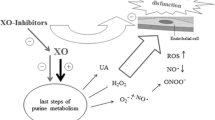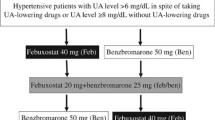Abstract
Aims
To determine whether low-dose aspirin and hydrochlorothiazide (HCTZ) affect the renal clearance of oxypurinol and/or urate.
Methods
Healthy volunteers (n = 8) were treated with allopurinol (600 mg, control), and allopurinol (600 mg) co-administered with single doses of aspirin (100 mg) or HCTZ (25 mg) or a combination of the two.
Results
Hydrochlorothiazide, low-dose aspirin or a combination of the two, when co-administered with allopurinol, did not significantly alter (P > 0.05) the renal clearance of oxypurinol or urate. In particular, aspirin and HCTZ, when taken together and with allopurinol, did not change (P > 0.05) oxypurinol fractional renal clearance (allopurinol alone: 0.217, 0.173–0.262; combined: 0.202, 0.155–0.250) or urate fractional renal clearance (allopurinol alone: 0.066, 0.032–0.099; combined: 0.058, 0.038–0.078).
Conclusions
A single, low-dose of aspirin or an anti-hypertensive dose of hydrochlorothiazide, when administered alone or together with allopurinol, are unlikely to alter the hypouricaemic effect of allopurinol. The effect of chronic aspirin and HCTZ dosing taken together upon the efficacy of chronic allopurinol therapy in patients with hyperuricaemia needs to be investigated.

Similar content being viewed by others
References
Walter-Sack I, de Vries JX, Ernst B, Frei M, Kolb S, Kosmowski J et al (1996) Uric acid lowering effect of oxipurinol sodium in hyperuricemic patients—therapeutic equivalence to allopurinol. J Rheumatol 23:498–501
Day RO, Graham GG, Hicks M, McLachlan AJ, Stocker SL, Williams KM (2007) Clinical pharmacokinetics and pharmacodynamics of allopurinol and oxypurinol. Clin Pharmacokinet 46:623–644
Breithaupt B, Tittel M (1982) Kinetics of allopurinol after single intravenous and oral doses. Noninteraction with benzbromarone and hydrochlorothiazide. Eur J Clin Pharmacol 22:77–84
Hande KR (1986) Evaluation of a thiazide-allopurinol drug interaction. Am J Med Sci 292:213–216
Elliott WJ, Weber RR, Murphy MB (1991) A double-blind, randomized, placebo-controlled comparison of the metabolic effects of low-dose hydrochlorothiazide and indapamide. J Clin Pharmacol 31:751–757
Leary WP, van der Byl K (1988) Diltiazem compared with hydrochlorothiazide in the treatment of mild-to-moderate essential hypertension. S Afr Med J 74:13–15
Jounela AJ, Lilja M, Lumme J, Morlin C, Hoyem A, Wessel-Aas T et al (1994) Relation between low dose of hydrochlorothiazide, antihypertensive effect and adverse effects. Blood Press 3:231–235
Kohvakka A, Salo H, Gordin A, Eisalo A (1986) Antihypertensive and biochemical effects of different doses of hydrochlorothiazide alone or in combination with triamterene. Acta Med Scand 219:381–386
Loffler W, Landthaler R, de Vries JX, Walter-Sack I, Ittensohn A, Voss A et al (1994) Interaction of allopurinol and hydrochlorothiazide during prolonged oral administration of both drugs in normal subjects. I. Uric acid kinetics. Clin Investig 72:1071–1075
Healey LA, Magid GJ, Decker JL (1959) Uric acid retention due to hydrochlorothiazide. N Engl J Med 261:1358–1362
Caspi D, Lubart E, Graff E, Habot B, Yaron M, Segal R (2000) The effect of mini-dose aspirin on renal function and uric acid handling in elderly patients. Arthritis Rheum 43:103–108
Segal R, Lubart E, Leibovitz A, Berkovitch M, Habot B, Yaron M et al (2003) Early and late effects of low-dose aspirin on renal function in elderly patients. Am J Med 115:462–466
Segal R, Lubart E, Leibovitz A, Iaina A, Caspi D (2006) Renal effects of low dose aspirin in elderly patients. Isr Med Assoc J 8:679–682
Yu TF, Gutman AB (1959) Study of the paradoxical effects of salicylate in low, intermediate and high dosage on the renal mechanisms for excretion of urate in man. J Clin Invest 38:1298–1315
Yamamoto T, Moriwaki Y, Takahashi S, Tsutsumi Z, Hada T (2001) Effect of furosemide on renal excretion of oxypurinol and purine bases. Metabolism 50:241–245
Stocker SL, Williams KM, McLachlan AJ, Graham GG, Day RO (2008) Pharmacokinetic and pharmacodynamic interaction between allopurinol and probenecid in healthy subjects. Clin Pharmacokinet 47:111–118
De Vries JX, Voss A, Ittensohn A, Walter-Sack I, Loffler W, Landthaler R et al (1994) Interaction of allopurinol and hydrochlorothiazide during prolonged oral administration of both drugs in normal subjects. II. Kinetics of allopurinol, oxipurinol, and hydrochlorothiazide. Clin Investig 72:1076–1081
El-Sheikh AA, van den Heuvel JJ, Koenderink JB, Russel FG (2008) Effect of hypouricaemic and hyperuricaemic drugs on the renal urate efflux transporter, multidrug resistance protein 4. Br J Pharmacol 155:1066–1075
Hagos Y, Stein D, Ugele B, Burckhardt G, Bahn A (2007) Human renal organic anion transporter 4 operates as an asymmetric urate transporter. J Am Soc Nephrol 18:430–439
Gurwitz JH, Kalish SC, Bohn RL, Glynn RJ, Monane M, Mogun H et al (1997) Thiazide diuretics and the initiation of anti-gout therapy. J Clin Epidemiol 50:953–959
Janssens HJ, van de Lisdonk EH, Janssen M, van den Hoogen HJ, Verbeek AL (2006) Gout, not induced by diuretics? A case-control study from primary care. Ann Rheum Dis 65:1080–1083
Khamdang S, Takeda M, Noshiro R, Narikawa S, Enomoto A, Anzai N et al (2002) Interactions of human organic anion transporters and human organic cation transporters with nonsteroidal anti-inflammatory drugs. J Pharmacol Exp Ther 303:534–539
Apiwattanakul N, Sekine T, Chairoungdua A, Kanai Y, Nakajima N, Sophasan S et al (1999) Transport properties of nonsteroidal anti-inflammatory drugs by organic anion transporter 1 expressed in Xenopus laevis oocytes. Mol Pharmacol 55:847–854
Acknowledgements
The research was supported by an Arthritis Australia National Research Grant and an NH&MRC Program Grant 568612.
Author information
Authors and Affiliations
Corresponding author
Rights and permissions
About this article
Cite this article
Ng, D.Y., Stocker, S.L., Graham, G.G. et al. Lack of effect of hydrochlorothiazide and low-dose aspirin on the renal clearance of urate and oxypurinol after a single dose of allopurinol in normal volunteers. Eur J Clin Pharmacol 67, 709–713 (2011). https://doi.org/10.1007/s00228-010-0963-6
Received:
Accepted:
Published:
Issue Date:
DOI: https://doi.org/10.1007/s00228-010-0963-6




